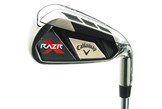Callaway Razr X irons: Q&A with design guru
Published: Last updated:
Callaway have long been known for their expertise in designing game-improvement irons to help high handicap golfers and the new Razr X irons are expected to carry on this mantle.
We’ve already brought you initial details of the new irons and they will be going head to head with the best the game-improvement market has to offer in our comprehensive irons test in April.
But for now we thought we’d bring you some information straight from the horses mouth with this Q&A with Callaway design legend Dr Alan Hocknell (official title senior vide president of R&D).
What was the design philosophy behind RAZR X?
We wanted to produce a club that that has the power and forgiveness of a wide sole iron, yet retains the versatility and workability of a narrow sole iron. In order to do this we needed to lower the centre of gravity without having to widen the sole, taking into account the fact that a large proportion of players hit lower on the face.
That’s where RAZR Technology came in. We designed the sole of the club so that we could redistribute around 30 grams of weight lower and deeper in the head, meaning that the CG is around 12% lower and 15% deeper than the X-22 irons. The unique shape of the sole gives great turf interaction and helps golfers execute shots from all areas of the golf course.
By incorporating RAZR technology into the design, we were also able to strengthen the lofts of the RAZR X irons compared to the previous X Irons, making them play slightly longer. However, we didn’t want to give up distance consistency, as this is obviously a very important attribute when golfers are hitting irons into greens.
Callaway has developed some specific design elements to its irons over recent years. Do any of these well-known attributes figure in the new RAZR X Irons?
The standard RAZR X model certainly has some of the key elements seen in previous, successful Callaway X irons. For example, both a short, straight, hollow hosel (S2H2), and Variable Face Thickness (VFT) Technology have been used.
Importantly, VFT has been reinterpreted to allow more of the hitting area to be more compliant lower on the face, allowing for greater ball speed in the area where golfers hit most of their shots.
We’ve also re-engineered the cavity. It’s not a 360-degree undercut cavity any more, it’s now nearer 330 degrees and we’ve put weight back into the undercut in a very specific place – it’s a more ‘high-def’ approach to designing the cavity.
Aside from the standard RAZR irons, you’ve also developed two other clubs in the family. How do they differ?
The new RAZR X Tour model is for the more advanced player who doesn’t need quite as much help. Again, this club has the RAZR feature, and although it’s not quite as prominent it does still allow us to strengthen lofts and improve distance without giving up trajectory height that this type of player prizes.
We’ve also been very conscious of the need to retain many of the elements that a better player would expect of a Tour iron – that means a more compact look and paying close attention to blade size, leading edge height, topline width, offset and a longer hosel.
As with the RAZR X, distance consistency is a really big attribute of this iron and our testing has found them to be the most precise Tour-type irons we’ve ever made, both in terms of the separation of distance from club-to-club and the tight grouping of shots hit.
And what about the elite player offering, the RAZR X Forged?
RAZR X Forged doesn’t have as much of the RAZR Technology as our Standard and Tour models, having been developed more as a result of Tour feedback. The subsequent shaping that designer Roger Cleveland has developed is based on his work with the Tour players and reflects their needs.
Where we have made some changes is in the playing characteristics. The long irons play, on average, about three yards longer, while some enhancements to the short irons have helped deliver more consistent distances, which is crucial for the important for very precise shot-making into greens.
One of the contributing factors to the overall effectiveness of RAZR X Forged is the inclusion, for the first time in a Callaway forged iron, of the new ‘Condition of Competition’ grooves. These are the highest spinning grooves that are currently available on Tour, as measured by Callaway against our competitors, and have already proved successful in victories at both the Masters and the US Open.
In addition to the thin topline, narrow sole and short blade length, the RAZR X Forged irons also feature a higher, squared-off toe and a sharper leading edge, giving total control and shot-shaping ability. It all adds up to a very strong package that is being embraced by our global team of Staff Professionals and will undoubtedly appeal to highly skilled golfers the world over.
Can you sum up what RAZR Technology means to the average player?
There are a lot of very new ideas in the RAZR X iron family– it’s a very bold step for Callaway and it is a completely fresh approach to how we engineer where the weight goes in the head. This approach has taken X Series to a completely different place… hopefully one that results in better shots, shorter putts and lower scores.



